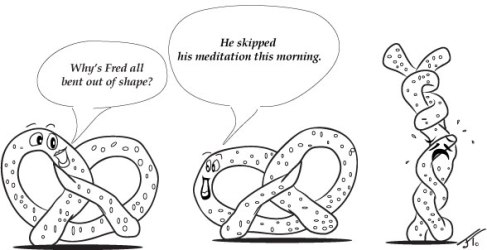Blessed are the flexible, for they shall not be bent out of shape.
On the surface that seems like just a humorous quip; maybe it gives you a little chuckle. But wait…give it a minute…swish it around a bit…and think about it again. It is actually very true on several levels.
From a physical standpoint flexibility has major benefits. Muscles only know how to contract; they won’t stretch themselves out unless we actively do it. For instance, if I flex my elbow by contracting my biceps the only way I am able to straighten that arm back out is by contracting an opposing muscle group, in this case the triceps. This is because the biceps doesn’t know how to stretch itself, it will hold that contraction until a force from another muscle group opposes it. When we think of exercise we often think of cardiovascular activities such as running, walking, or other sports that raise the heart rate. Maybe we even key in on strength training workouts like weight lifting or calisthenics, but we often don’t do enough when it comes to stretching. By increasing flexibility we can reduce our risk of muscle injury, improve performance, reduce muscle soreness, improve posture, increase blood flow to tissues, improve muscle coordination, and maximize the ranges of motion of our joints. All good things.
But what about the idea of being flexible from an emotional perspective? Is this something that can be practiced? My answer to that is an overwhelming yes! And it is my opinion that yoga is a perfect way to get your stretch on both physically and mentally. During a yoga practice, as you move through a series of postures, you are working on improving your physical flexibility. But you can certainly use your time on the mat to improve your mental outlook and emotional flexibility as well. There are many lessons to be learned from a yoga practice that transcend the physical postures.
We tend to be creatures of habit, we fear change, we allow ourselves to feel the pressure of stress, and our expectations often remain relatively rigid. The stringency with which we approach daily life makes handling the curveballs rather difficult.
This week during your yoga practice take note of the times on your mat when you are feeling shaky. During those moments focus on your breath. Set your gaze and concentrate on deep inhales and even exhales. I’d be willing to bet that you will make it through the shakiness. Maybe you have similar feelings during certain moments in daily life; times when you get the sense that you’re being pulled in numerous directions. Same as on your mat, during these instances you can breathe. Concentrate on what you need in the present moment, which is your breath, and try your best to stand strong.
You can also take note of the times when you feel some discomfort in your yoga practice this week. Maybe during a certain pose you feel muscle soreness as you are approaching fatigue. Maybe your mind is telling you to give in and retreat from the posture, but you can breathe—concentrating on deep inhales and even exhales to get you past the mental hurdle. Again, you’ll probably notice moments in day-to-day life where you experience similar feelings of discomfort; times when you are unsure of your abilities. But, again, you can use that lesson from your mat and breathe. Focus on the breath to get you through.
I think you probably understand what I am getting at here. The fears, judgments, insecurities, and stress that we often succumb to on a daily basis are really just moments of emotional inflexibility. During those times, if we take a step back and focus on the only thing we truly need in the present: our breath, then we can pull through the difficult times. In this way we will become more flexible, more able to roll with the punches, more able to handle whatever comes our way with grace, and maybe we won’t so easily be bent out of shape…
